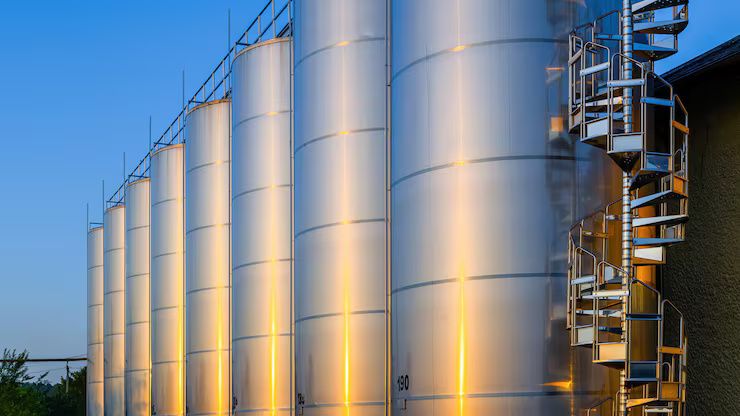
Industrial Storage Tanks Explained: Guide to Materials, Types, and Practical Applications
Industrial storage tanks are large, mostly rigid containers designed to hold liquids (or in some cases solids or gases) in an industrial setting. They come in many shapes, sizes and materials, and are used in sectors like oil & gas, chemicals, water treatment, food processing, agriculture and more. At a fundamental level, the topic exists because industries need safe, stable, efficient means to store large volumes of material — whether raw feedstocks, intermediate products or final goods.
Over time, as industries scaled up and materials became more varied (e.g., corrosive chemicals, cryogenic liquids, high-pressure gases), the design, material selection, safety features and regulatory requirements for storage tanks became more sophisticated. When you see a large above-ground cylindrical tank at a refinery, a horizontal buried fuel tank at a facility or a stainless-steel vessel in a food plant, those are variations of industrial storage tanks adapted to particular needs.

Importance
Why this topic matters today — and who it affects.
Who it affects:
-
Facility engineers and plant managers responsible for design, installation and maintenance of storage systems.
-
Operations, safety and maintenance teams tasked with ongoing integrity, inspections and risk mitigation.
-
Regulators and environmental-safety professionals overseeing compliance and spill prevention.
-
Industries that rely on bulk storage — e.g., petroleum, petrochemicals, agriculture, food, power generation, water treatment.
What problems storage tanks help solve:
-
They provide safe containment of large volumes of liquids (or solids) in one place, enabling efficient handling, processing and distribution.
-
They help in buffering supply and demand — e.g., holding feedstock when production is higher than consumption, or storing final product to enable transport.
-
For hazardous or sensitive materials, appropriate tank design helps protect environment and human safety (by preventing leaks, spills, emissions, corrosion).
-
They enable economies of scale — large volume storage often reduces logistics costs and production interruptions.
Why it matters now:
-
With increasing focus on environmental protection, leak detection, secondary containment and life-cycle management of infrastructure, choosing the right tank material and design is more important than ever.
-
Industrial operations face cost pressures and regulatory demands that make integrity and durability of storage tanks a competitive and safety issue.
-
The diversity of materials stored (chemicals, bio-materials, cryogenics, water, fuels) means that one “tank solution” does not fit all — material, pressure, temperature, containment systems all vary.
Recent Updates
Here are some recent trends and changes in the world of industrial storage tanks (as of 2024-2025):
-
A blog published in May 2025 highlights that for industrial storage tanks the tank material must match the stored substance, noting that “heat, pressure, and outside exposure all affect tank life.”
-
The same source discusses that storage for solids (e.g., pellets, powders) is increasingly relevant and may require special tank internal designs (e.g., slopes, cones, vibration) to prevent clogging.
-
Regulatory updates: For example, in Canada, the “Storage Tank Systems for Petroleum Products and Allied Products Regulations” cover fixed-location tanks with capacity > 230 litres under federal jurisdiction, and underscore newer requirements for leak detection and containment.
-
There is growing emphasis on digital monitoring, sensors for tank integrity (corrosion, settlement, leak detection), and use of remote data for maintenance planning (this is more an industry trend than a specific regulation).
-
Materials innovation: greater use of composite materials, advanced coatings, corrosion-resistant alloys or non-metallic liners in tanks storing corrosive or aggressive chemicals.
-
Sustainability & retrofit: Existing large tanks are being assessed for life-extension, secondary containment upgrades, bunding improvements, and alignment with environmental risk controls.
Laws or Policies
Industrial storage tanks are subject to a variety of regulations depending on country, material stored, location (above ground vs underground) and hazard potential. Here are key regulatory themes:
-
In the U.S., the Environmental Protection Agency (EPA) regulates underground storage tanks (USTs) under federal law (e.g., 42 U.S.C. § 82, Subchapter IX). These rules cover leak detection, corrosion protection, operator training and financial responsibility.
-
In India, for example the Petroleum and Natural Gas Regulatory Board (PNGRB) sets guidelines for bulk storage tanks (above-ground, underground, semi-buried) including design standards (IS 10987 or equivalent), separation distances, bunding, fire protection etc.
-
In the UK, the Control of Pollution (Oil Storage) (England) Regulations 2001 set rules for fuel/oil storage above certain volumes including bunding requirements, clearances from water-courses and flood risk zones.
-
For above-ground and underground tank systems in Canada, the “Storage Tank Systems for Petroleum Products and Allied Products Regulations” include identification, registration-and-tracking, risk assessment and operator requirements.
Key regulatory themes to note:
-
Permitting/registration of large tanks or facilities holding hazardous or regulated materials.
-
Requirements for secondary containment (bunds, sumps, liners), separation distances from boundaries or sensitive zones.
-
Leak detection, corrosion control, inspection regimes.
-
Safe entry procedures (for maintenance/cleaning) under occupational safety rules (e.g., Occupational Safety and Health Administration (OSHA) confined-space rules in U.S.).
-
Material, construction and inspection standards (e.g., American Petroleum Institute (API) standards for tanks).
When designing or operating industrial storage tanks, professionals must ensure they comply with the applicable local, national and sometimes international standards for design, operation, safety and environment.
Tools and Resources
Here are helpful tools, websites and resources related to industrial storage tanks:
-
Industry design standards: e.g., API 650 (Welded Steel Tanks for Oil Storage), API 620 (Design and Construction of Large, Welded, Low-Pressure Storage Tanks) and relevant IS/BIS standards in India.
-
Online calculators and software: Many engineering firms offer tank capacity calculators, pressure/volume tools, settlement or structural-analysis templates (though proprietary). For example, spreadsheets to estimate required thickness, bottom settlement, slope of tank pad.
-
Regulatory guidance portals:
-
EPA’s online section on UST laws & regulations (USA) summarises requirements.
-
Environment & Climate Change Canada’s guide to storage tank regulations.
-
-
Inspection checklists and maintenance templates: Many professional associations provide PDF or Excel checklists to inspect tank exterior, roof seals, manholes, corrosion, settlement.
-
Industry blogs and white-papers: For example the AstecTube blog on industrial storage tanks (May 2025) discusses materials, selection criteria.
-
Professional training and certification: Occupational safety courses (for confined-space entry in tanks), corrosion/integrity management programmes.
-
Seismic or structural assessment tools: For tanks in earthquake-prone zones, relevant analyses (structural simulation software) may be used.
Using these tools and resources helps ensure selection, installation and ongoing operation of industrial storage tanks meet performance, safety and regulatory expectations.
FAQs
What are the most common materials used for industrial storage tanks?
Common materials include carbon steel, stainless steel, aluminium, composite materials (e.g., FRP – fibre-reinforced plastic) or lined steel (with internal coating or plastic liner). Material choice depends on the stored substance (corrosiveness, temperature, pressure), external environment (outdoors, underground), and lifetime/maintenance expectations.
How do I choose the right type of tank for a given application?
You’d evaluate:
-
The substance being stored (liquid, fluid, solid; corrosive or benign; temperature, pressure)
-
The required capacity (volume) and space constraints
-
Above‐ground vs underground installation (each has trade-offs)
-
Material compatibility, expected life, maintenance needs
-
Regulatory and safety requirements (containment, separation distances)
By assessing these factors you can select an appropriate tank type and material.
What are the main types of storage tanks?
Some of the main types:
-
Above ground vertical cylindrical fixed-roof tanks
-
Above ground floating-roof tanks (external or internal floating roofs) for volatile liquids.
-
Underground or semi-buried tanks (often for fuels or storage where space or aesthetics matter)
-
Horizontal tanks (especially smaller volumes)
-
Pressure vessels / cryogenic tanks (less common in “normal” industrial storage)
-
Solid material storage (tanks or silos for powders/pellets) – special internal geometries to ensure flow.
What are key maintenance and safety considerations?
Important items include:
-
Regular inspection for corrosion, settlement, leak paths, roof seal integrity
-
Ensuring secondary containment (bunds, sumps) to capture spills
-
Monitoring and instrumentation (level alarms, high-level cut-off, over-pressure relief)
-
Entry procedures for cleaning or inspection (confined-space rules)
-
Ensuring electrical safety and hazard classification in zones where flammable liquids are stored
-
Maintaining documentation of the tank’s condition, operating history, modifications and inspections.
-
Ensuring clear access for emergency response, and spill-response plans.
How do regulations affect storage tanks in India?
In India, bulk storage tanks for fuels or chemicals are governed through standards and rules that cover separation distances (between tanks, and tanks-to-boundary), bunding, venting, manholes, roof design etc. For instance, PNGRB guidelines require above-ground, underground and semi-buried tanks to follow IS 10987 or equivalent industry standards. Also, any change in tank design, size or contents may require hazard-analysis studies such as HAZOP or QRA (quantitative risk analysis).
Conclusion
Industrial storage tanks are a foundational element of many industries — providing the means to store, buffer and manage large volumes of liquids (and sometimes solids) under controlled conditions. Understanding the materials, tank types, design considerations and regulatory framework is essential for safe, reliable and efficient operations. As operations evolve, with new materials, new safety demands and tighter regulations, the role of proper tank selection, maintenance and compliance has never been more important. With the right tools, standards and practices in place, facilities can ensure storage systems perform their role effectively — supporting operations, protecting people and the environment, and maintaining long-term value.






